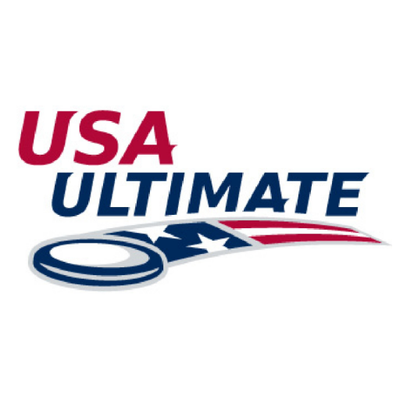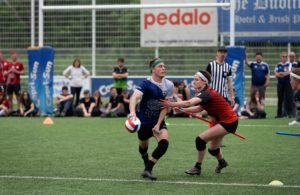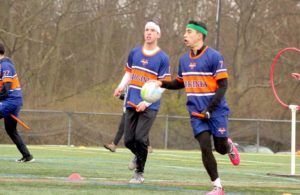- Rule, Britannia, no more?
- Unpopular Opinions: US Quadball Cup 2023
- Proven Contenders: University of Virginia
- Proven Contenders: Rutgers University
- Proven Contenders: University of Michigan
- Proven Contenders: Creighton University
- Different Perspectives: A Look Inside USA Ultimate
- Antwerp QC, Much of Belgian Core, Leaves Competitive Quidditch
Different Perspectives: A Look Inside USA Ultimate
- By Tad Walters
- Updated: January 14, 2021
With COVID-19 threatening US Quidditch’s sustainability and many players questioning what the future holds, it’s time our community looks outward and takes notes from other sports leagues. While I have been a very vocal proponent of taking cues from the sport Ultimate, I figured now was the best time to explain the structure of USA Ultimate (USAU) and what I feel we can garner from them. I’ve also taken the time to speak with Will Deaver, the Managing Director of Competition and National Team Programs at USAU to shed some light on how USAU has created their league structure based on feedback from teams and addressing the needs of the community. There will be another companion article coming soon with examples of what a quidditch season could look like if we followed USAU’s example!
Credit: usaultimate.org
Below is a basic timeline for the USAU college season, USAU club season, and the AUDL(American Ultimate Disc League) season
College Season Begins: January 3rd
College Regular Season Ends: March 29th
Conference Championships: April 11th-19th(Two weekends)
Regional Championships: April 25th – May 3rd(Two weekends)
D3 Nationals: May 16-17th
D1 Nationals (Memorial Day weekend): May 22nd-25th
AUDL Season Begins: April 5th
USAU Club Season Begins(Triple Crown Tour): June 6th
AUDL Championship weekend: August 10th
USAU Club Regular season ends: August 30th
Sectionals: September 13th
Regionals: Sept. 26th-27th
National Championships: October 22nd-25th
THE COLLEGE SEASON
The college season opens at the beginning of January and ends on Memorial Day weekend (May 22nd-25th). The preceding months are used by some teams to hold unofficial tournaments, train rookies, and tweak strategies to prepare for the regular season in January. Come January, many teams have opportunities to play locally either because of good weather or indoor facilities. However many teams in the North and Midwest will travel south or west for the opportunity to play and build their rankings going into the postseason. While teams can play each other in the regular season, collegiate ultimate is actually split into D1 and D3.
Inside USAU With Will Deaver
Tad Walters (TW): What’s the difference between D1 and D3?
Will Deaver (WD): While we use the same names, our D1 and D3 are different from the NCAA’s. D3 is for newer teams and for schools with less than 7500 students. We have a model where you play anyone in the regular season, but when it comes to the postseason, you have to pick one or the other. There are opportunities for D3 teams to move up, but you have to play at a certain level and you have a choice. D1 teams however cannot play down, which is a semblance of protection for D3 schools.
Some schools like Carleton College have a history of high level ultimate and that’s what it’s known for, so they continue to play in D1 but a lot of schools like Wesleyan and Middlebury who used to be in D1 are now D3 with schools like Oberlin. Big state schools just have a huge advantage when it comes to school population, school facilities, so it takes a special group to recruit at these small schools and create athletic teams that can hang in D1.
Note: The collegiate regular season ends at the end of March, with a two-week break before conference championships in Mid-April. Teams will compete at conference championships to qualify for regionals in two more weeks time. The season culminates with a D-3 national championship tournament in Mid-May followed by the 20-team D-1 national championship tournament on Memorial Day weekend.
TW: Do teams ever drop out of Nationals because of its proximity to finals/graduation or due to school restrictions?
WD: No, but some schools handle these things very differently and those restrictions do happen. However, with Ultimate there is usually a connection between the ultimate teams and their school. These are teams that are club sports at the universities. However, when some teams get started, they have to face some of the same challenges as teams 10 years ago, with the difference that ultimate is more well known. But teams don’t usually drop out for those reasons.
We have talked about moving it[the date of Nationals] because of graduation but the holiday works because of the attention, the flexibility for travel for spectators and volunteers, and it’s great to not have to guess when nationals is going to be every year. Teams can accommodate ahead of time!
Just two weeks after collegiate championships, the Triple Crown Tour, USAU’s club season, begins.
Credit: usaultimate.org
TW: What exactly is the Triple Crown Tour?
WD:In 2012, we formalized club and created the Triple Crown Tour, which is headlined by three major events, US Open, Pro Championships, and National Championships. US Open is kind of festival-ish, and has the top eight teams plus top international teams and the Youth Club Championship. Teams are in good form, but not quite Nationals ready. Pro championships is the last regular season championship, with the top eight teams and two wild card spots, followed by the postseason(Sectionals and Regionals), which ends with a 16 team National Club Championships
Triple Crown Tour (TCT) is a structure we put in place to give some form to the regular summer club season. The National Championships is at the end of October, preceded by sectionals and regionals in September. Throughout the season there are team-hosted tournaments and random events just as kind of prep for the postseason. The TCT created sanctioned events that count towards record and rankings and inform how many bids a section will have at Regionals, and how many bids a region will have at Nationals. We also created four flights of teams: Pro(Top 8 teams in the country), Elite(9-16th best teams), Select(Next best 32 teams), and Classic(Everyone else). Depending on how you do each season at Nationals, you get promoted or relegated and get invited to special events for various flights.
Credit: usaultimate.org
The Classic flight is usually for smaller market teams, a second team in an area, casual teams, and teams who are working on improving to get to Select.
TW: Is it difficult trying to accommodate all the players in the league?
WD: Yes. You have all these teams with different visions and it can be frustrating playing each other all the time when they have different goals in mind. But there are benefits for all levels, from tournaments made for certain flights or combinations of flights, to fun casual tournaments like Poultry Days in Ohio, where people wear costumes and such. It really just depends on what opportunity you’re looking for in Ultimate, and we just try to offer as much as can.
The difference between USAU and AUDL was that we felt it was important when putting together the structure, to make sure that we had something for all our athletes. We weren’t just focusing on the top teams, so we have a very broad structure that has a ton of advantages. The semi-pro leagues, on the other hand, cater to the top slice. They do weekly play, play in a stadium, and put their product in front of fans. We focus on tournament play rather than match play.
TW: With Club and College happening in different parts of the year, do college players play club at all?
WD: Yeah, I’d say that 20 to 30% of club players also play college, but there’s less overlap in top club teams. We did once think about moving club earlier in the year, but we discovered quickly that it would have been tough on the community, especially because so many coaches of college teams are also club players, so we decided to continue not having overlap in the seasons.
I spoke with Ben Lamport, the coach of Tucks, or Tulane University’s Men’s Ultimate Team, where he himself played in college. He said, “The best thing for my development as an ultimate player, and my success in the college game, was the ability to play club ultimate in the summer. Getting to play with, compete against, and learn from better, faster, and more experienced players raised my ceiling when playing against other college students. For this reason, I’ve always tried to convince the college players I coach to play club in the offseason, and it’s always easy to tell which players come back to school in the fall with another season of club under their belts”
Photo Credit: Tulane Men’s Ultimate (Tucks)
AUDL
Credit: theaudl.com
The AUDL is a 22 team semi-professional ultimate league that features weekly play and a long postseason. The season starts in early April, with the championship weekend in early to mid August.
TW: Was there any conflict between club teams and the AUDL when they started?
WD: When they first started they were mostly in non-major ultimate cities, trying to get teams in cities that were not traditionally huge hubs for the sport, to avoid stepping on the toes of the top club teams. It was really different depending on the city but in some cities players were separate and it really depended on local leadership. Some teams have used both club and the AUDL to build up both teams, but in some places club team stays the priority, for instance most top ultimate players in Seattle play Sockeye(club team) and not Cascades(AUDL team)
TW: Do club and the AUDL have events that overlap?
WD: Yeah it’s a bit unavoidable since there is only so much time during the summer. There hasn’t been a coordinated effort to prevent overlap, but none of the major events overlap and the AUDL postseason ends right as USAU’s postseason begins.
TW: What things does USAU do to promote Youth Ultimate?
WD: USAU owns the state Youth championship events and there are coordinators that work with organizers at the city and state level to run leagues that lead to those championships. We host the end of season state tournament and support that by setting the schedule, evaluating event bids, and having basic eligibility rules that states can add on to. Beyond the play, there’s a lot of focus on coaching education, there’s grants and support we give to local orgs,a learn to play program, teaching clinics, Girls’ Ultimate Movement(GUM), and more.
Credit: usaultimate.org
TW: How has USAU held up during COVID?
WD: We make our money through events and memberships, and membership took a big hit. We were fortunate to get through a good amount of the college season before March shut everything down, and we’ve had operating reserves in the bank to help us deal with rainy day stuff. Not to say we anticipated this, but it did give us a leg up! We also applied for government assistance and were able to get some of that which helped us keep staff. We actually had some natural attrition in the months before COVID, so we just put hiring on pause and have been working with a smaller staff. We, unfortunately, did have to do some furloughing over the summer and fall, and as far as in-person activities we’ve of course had to cancel everything.
We’ve since been working with a medical advisory group that helped us put together return to play guidelines and we came up with new programs aimed at smaller groups and individualized training play. We’re looking at 2021 and hoping to get back to it in the summer but it’s a lot of wait and see right now.
TW: How did y’all bridge the gap between making money as an organization and making the sport accessible?
WD: Something it took us a while to realize is yes, you have to keep it affordable so there is not a huge barrier to getting involved. It does cost money to do this stuff, and it’s okay to charge for it! But there are people who can’t afford it, so I think identifying groups that do need assistance and do need help is very important, especially now with a rising focus on equity and diversity in the sport.
For more information on the college division:
https://www.usaultimate.org/college/
Fro more information the Triple Crown Tour: https://www.usaultimate.org/club/
For more information on AUDL: https://theaudl.com/
Thank you to Will Decker and Ben Lamport for taking the time to speak with me and share their experiences from the sport of Ultimate!
Related Posts
About Tad Walters
Tad is a three-year veteran of Loyola University - New Orleans quidditch. He led them to a Div. II finals appearance at World Cup VI. He also was one of the eight snitches chosen for Global Games 2014. After infrequent work as an IQA staff writer, and as the writer of his own blog "You Tad, Bro?", he was told he was now writing for The Eighth Man, which he has no problem with. When he's not hitting little girls in the face with a dodgeball, he enjoys collecting coins, intense Facebooking and making seekers look silly.









